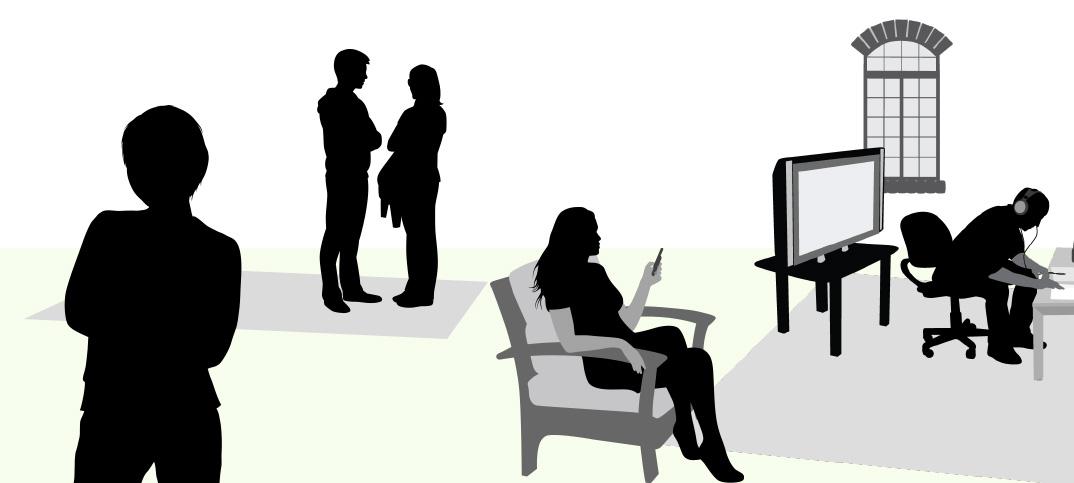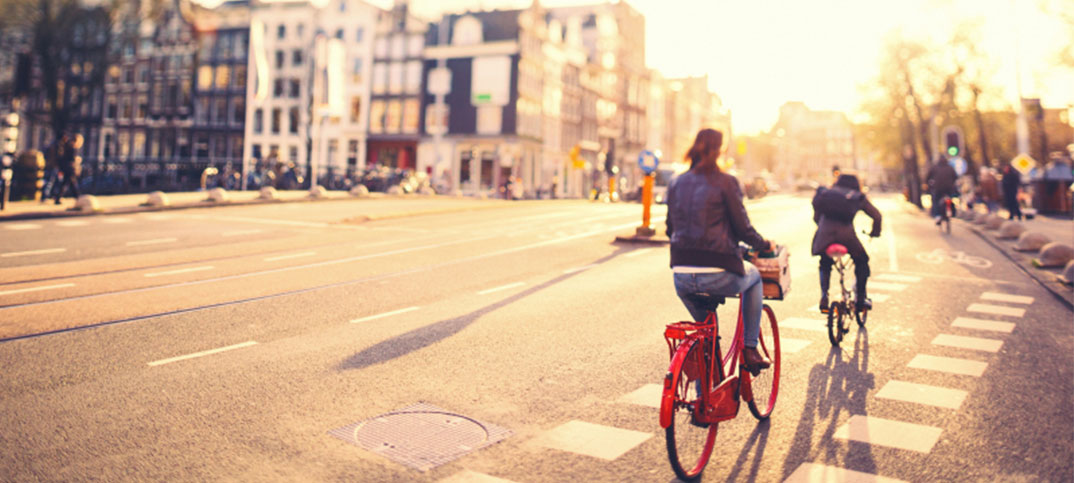Microtravel: How to get away without going away
Rate this article and enter to win
What’s your vacation destination situation? If funds are low or time is short, you may be resigned to not getting a summer break from your regular life. In that case, this word is for you: microtravel. Microtravel means experiencing your own town or state as a visitor or explorer would, putting aside your usual routine, and embracing discovery. (Yes, it’s pretty much the same concept as “staycation,” but without the hint of inertia.) Travel comes with health and wellness benefits, and our happiness comes from our experiences, not our stuff. Microtravel is a sure way to add to those experiences.
In a recent survey by Student Health 101, 63 percent of respondents said they’d had at least one microtravel experience or staycation. “It’s a blast if you plan it and don’t let yourself get stuck in the mindset that it’s just your town, there’s nothing to do there,” says Spencer R., a second-year undergraduate at the University of North Dakota.
6 motivations for microtravel
1. You won’t spend much money
“Staycations are tha bomb diggity. Cheap, low risk.” —Sal I., second-year undergraduate, Michigan Technological University
2. You’ll minimize travel stress
There’s little risk of flight delays or missed connections. And if the prospect of travel makes you anxious, this is a great way to start. “The best part is you’re already there, so you just get up, go, and explore!” —Paula L., first-year undergraduate, Clemson University, South Carolina
3. You can easily go solo or social
The logistics, time, and costs of microtravel are not too onerous, making it easy to team up with partners, friends, and family—if you want to.
4. Your discoveries will enrich your regular life
Those new eateries, friends, and activities—they’re keepers.
5. You’ll get to be spontaneous and flexible
Ever felt obligated to visit the ancient relics, or devastated that the volcano you came for was hidden in the clouds? When you’re microtraveling, the stakes are lower.
6. You can cherish your roots and your locality
Microtravel is a way to honor your family traditions (or make new ones) and explore your local heritage.
The freedom, health, & happiness of travelRun free
Students associate travel with freedom—for example, a break in academic and work expectations, a boost to emotional health and relaxation, and an opportunity to experience nature—according to a small study by researchers at California Polytechnic State University (2010).
Stay healthy
Physically active leisure helps people maintain physical and mental health, especially during times of stress, according to a study of 20,000 people in the Canadian Journal of Public Health (2001).
Love your life
Even the anticipation of vacation travel makes us feel good about our lives and health, according to a 2002 study in the Journal of Vacation Marketing.
Go global (with moderate expectations)
Students expect travel to make them more “global”—i.e., expand their knowledge, perspective, and social and cultural connections—according to the same California Polytechnic State University study (2010).
Get creative
Knowing people from other cultures makes us more creative in tasks that draw on multicultural influences and more receptive to new ideas from outside our own experience, suggests a study from Harvard Business School (2011).
Your microguide to microtravel
 |
Consider a quirky theme or idea |
A theme or project can help shape your microtravel explorations. “[You] definitely want to get creative, because [when] you’re so familiar with an area it can seem pretty mundane. Think outside of the box and you can’t not have a good time,” says Jonathan M., a fourth-year undergraduate at The College of New Jersey.
Students: Ideas that made our microtravels“My boyfriend and I were both broke. We bought disposable cameras and drove around town taking pictures in front of different things or places that started with each letter of the alphabet, like Rockin’ Robin’s Cafe and Ice Cream Parlor for the letter R. It was so much fun and basically free! We got to experience the little town where we grew up in a whole new way.” —Brittney B., second-year undergraduate, University of Central Arkansas
“Think of something that your state isn’t really known for, then try to find a way to do that.” —Casey S., first-year undergraduate, New Jersey Institute of Technology
“During my undergrad in Atlanta, I loved exploring the city to find the urban art murals by street artists. It’s always fun to take a picture in front of it and admire their talent. It’s completely free and gets you out and about. You can do it walking or in a car.” —Nilza S., second-year graduate student, Clemson University, South Carolina
“My girlfriend and I just decided to take off to the mountains and see how many small little nowhere towns we could visit. It was fun, scary at times, but overall very memorable.” —Tanner S., third-year undergraduate, Metropolitan State University of Denver, Colorado
“Sometimes it’s fun to dress/act the part—employ your imagination to maximize the fun times. I used to live in the Florida Keys, and one of the best staycations was dressing like a gaudy tourist and visiting all the attractions.” —Liz S., second-year graduate student, University of Maryland
 |
Remember to do all the things |
Microtravel means finally having time for that stuff you can’t usually do. “Keep a list throughout the year of places you want to go to but don’t necessarily have time to go to,” says Taylor S., a second-year undergraduate at Tulane University, Louisiana.
Students: What we did with that time when we got it“Going for bicycle rides and hitting up the wineries and breweries like a tourist is always good fun, staying the night at a hotel out at the coast. There’s a reason people from all over the world come here.” —Jason K., first-year graduate student, Sonoma State University, California
“[I would do] different types of fitness classes that I otherwise cannot fit into my day, and different art museums/studios that I may not want to do in my normal weekend routine (or maybe those facilities are too busy on the weekends).” —Kristen S., second-year graduate student, Hofstra University, New York
“I have lived in my college town for almost two years. Any time my family stops by, we all stay in a hotel (even though I could stay at my own place) and we experience new aspects of the city together. Some things, such as the farmer’s market, we experience over time, but for the most part we try different museums and festivals and scavenge for different food spots.” —Jordan M., second-year undergraduate, Drake University, Iowa
“I’ve lived in Wyoming for around eight years, and not once had I been to Yellowstone. Last year I was working in an oil refinery in Montana shortly before my first semester was to begin. My sister and mother drove up there to bring me home. On our way back home we randomly decided to go to Yellowstone. We spent all day at the park, and it was beautiful. Surely a great memory with the people I’m closest to.” —Miguel S., first-year student, Western Wyoming Community College
 |
Seriously consider leaving home |
When you microtravel, it’s vital to establish boundaries to protect against the distractions of regular life. That’s especially important if you’ll be based at home.
Students: When to lose (or keep) the homing instinctProblem
“I feel like individuals still fall into their routines and won’t disconnect like they would on a vacation. Instead they may feel the need to clean up around the house or declutter.” —Kristen S., second-year graduate student, Hofstra University, New York
“Another [drawback] is having work readily available, since you are at home or close to it.” —Name withheld, second-year online student, Fort Hays State University, Kansas
Solution
“Stay in a hotel or hostel so that you don’t have to go home, and then you can spend more time relaxing, and perhaps use the hotel spa to relieve the stress of your day-to-day life.” —Kelsey R., first-year undergraduate, University of North Dakota
“My most memorable staycation was spending time at a local bed-and-breakfast where I grew up and doing the things that were recommended by the owners and were in walking distance. There are so many things I hadn’t even thought to try until the exposure and opportunities were given to me. Alaska has so much to offer.” —Brynn J., second-year undergraduate, University of Alaska Anchorage
Unless being at home is the point
“[I went] camping in my backyard with my little brother.” —Robert G., fourth-year undergraduate, Hofstra University, New York
“I got to stay at home over winter break and visit with old friends
I had not seen in a while.” —Name withheld, fourth-year undergraduate, University of Maryland Baltimore Country
 |
Got public transportation? Use it |
Even if public transportation doesn’t feature much in your regular life, take another look at the routes and schedules (if you have access to them). Buses and trains can deliver you affordably to many adventures.
Students: How we got around“Start small and use the public transportation. It’s a great learning experience and puts you in closer proximity to the locals.” —Courtney F., fourth-year undergraduate, University of Kansas
“[I did a] tour of Portland using all modes of transportation available—train, car, walking, hiking, streetcar, and elevated tram.” —Dave S., fourth-year graduate student, Oregon Institute of Technology
“Traveling to the beach/tide pools in the San Diego area—I love just getting on the 30 MTS bus and taking it south and getting off at a random spot. One time, I came across a sick sea lion pup with another group of people. We called the rescue people, and they came and took him to safety.” —Gillian E.-E., fourth-year undergraduate, University of California, San Diego
“Uber is also a great way to get around; going from bar to bar or something like that. I want to do this, get my friends, get a room somewhere. For me, travel is typically such a pain. The airport security look suspiciously at my braille laptop, and they try to take my cane, and ask if I need my service dog with me. Apparently, somewhere I signed on to educate the ignorant.” —Caitlin W., fifth-year undergraduate, Northern Illinois University
 |
Plan your plan |
Figure out your policy on planning. The risk of going planless is that the demands of routine life may encroach on your precious exploration time. On the other hand, spontaneity is a rare pleasure. “Planning or spontaneity can set the tone for the vacation and can present its own set of pros and cons,” says Cristophet C., a first-year graduate student at the University of California, San Diego.
Students: The pros and cons of planningThe plan plan
“Staycations can become fun as long as they are thought out decently; otherwise you just view your time off as wasted.” —Aron A*., second-year graduate student, University of North Dakota (*Name changed)
The no-plan plan
“You just have to let yourself go wherever you feel your feet are taking you. If you have no idea where you are, that’s even better. It makes the experience more enjoyable and chances are, when you are trying to find your way out, you will find something amazing that you would never have even seen.” —Elizabeth S., first-year undergraduate, University of Wisconsin–Eau Claire
The part-plan plan
“It helps me to make a schedule for the first part of my staycation, to help get into the ‘vacation mood,’ and then leave the latter part a little looser, to decide as I’m going along.” —Reba S., second-year graduate student, University of Wisconsin–Madison
“Having a plan helps, but always be ready for the unexpected. Spontaneity can sometimes be the best part of your staycation! And to make it work you just kind of have to pack your bags and leave. I’ve rarely planned a staycation down to the last detail; it’s more fun to be spontaneous with it!” —Name withheld, fourth-year undergraduate, East Tennessee State University
 |
Switch off when you can |
To protect your downtime and your headspace, try a remote campsite or B&B beyond the reach of phone signals or wifi. You probably won’t get irretrievably lost in the woods—and a printed map (remember them?) is great for getting found again.
Students: How to disconnect“It was a three-day backpacking trip, and I went with a group of six. We packed all our food and belongings into four large Tupperware bins and canoed out for about three hours to a desolate island in the middle of the Everglades. No phone service, no water, no electricity. It was great!” —Andrea W., graduate student, University of Miami, College of Arts and Sciences
“Put down your cell phone and get off your computer and enjoy the outdoors.... I went to Ricketts Glen State Park, Pennsylvania, with my girlfriend’s family. It’s about three hours from home, and there’s no TV or cell service. Board games, hiking, snow, and family.” —Ben G., fourth-year undergraduate, Harrisburg University of Science and Technology, Pennsylvania
“Rather than taking out your phone to take photographs and video, use a disposable, digital, instant, single lens, or any other type of camera. Another option is to not take photos or video at all, to allow oneself to immerse fully in the present.” —Amy N., fourth-year undergraduate, Western Washington University
“If you are so in love with a town, it can change, and if you used to hate it, it can become the most beautiful city you have ever seen and experienced.”
—Callixte N., first-year graduate student, University of North Dakota
“I was so amazed by the old and the new that I have taken for granted for so long.”
—Emily L., third-year undergraduate, University of New England, Maine
“The key is to not think that this is what you’re doing because you can’t afford to do otherwise. You should be entirely into this and try to get the most out of it.”
—Elham M., graduate student, Clemson University, South Carolina
Students’ stories
Alone
“It sometimes feels best when experienced alone. I finally explored downtown LA and all the museums that were so close to me, [which] I never visited.” —Nur B., fourth-year undergraduate, University of California, Los Angeles
“Last year for fall break I stayed in St. Louis and explored the city on my own. It was a really nice experience and more relaxing than having to fly or travel to another location.” —Kriti P. third-year undergraduate, Washington University in St. Louis, Missouri
With a friend
“My best friend and I used a weekend to visit different tour spots in our hometown. First, we went to a local rafting place we had never been. It was a blast! After taking a catamaran down the river, we then went to a local putt-putt golf place. We played all 18 holes; I even got a hole in one!” —Abby B., second-year undergraduate, Northern Michigan University
“Went hiking with a friend of mine. Awesome experience.
Saw new sights that I’ve never seen before and pushed
myself to complete things that I hadn’t done.” —Luciano E., third-year undergraduate, New Jersey Institute of Technology
In a group
“I visited Nashville in December for the first time with an all-women group from my church. We toured three of the [historically] black colleges. We enjoyed the beautiful Christmas decorations and lights. Enjoying a nice restaurant and shopping was a treat.” —Name withheld, fourth-year undergraduate, The University of Memphis, Tennessee
“I find it’s better to go in smaller groups than in larger groups. It makes things more intimate, and people tend to not split off into smaller groups.” —Arnaldo M., fourth-year undergraduate, Florida International University
“One weekend, a group of us went the Getty museum and tried a new burger place (thank you, Yelp—great suggestion). Afterward we went to Venice Beach and the Santa Monica Pier. The next day we woke up early, hiked to the Hollywood sign, had a picnic in the park, then ended the day with a movie at a new theater that has reclining seats—super cool. It was all pretty spontaneous, and we all had a great time!” —Briana R., third-year undergraduate, California State University, Channel Islands
“I went to a different state where food and hospitality was very different from mine. It was new and refreshing, and I took stuff home and integrated it into my daily life.” —Name withheld, second-year undergraduate, University of Maryland, College Park
“I made it a goal to eat at a brand-new place every day of the week. The experience really opened my eyes to how much more my hometown has to offer.” —Eddie F., third-year undergraduate, University of Massachusetts Lowell
“It opened more doors for me as far as networking and social events. I got the chance to explore the best restaurants and social clubs.” —Rahul S., fourth-year undergraduate, Northern Illinois University
“Boston is big enough that you definitely won’t go everywhere your first year. I mentioned to this guy that I had never seen the Public Garden, and he took me there as our first date. We’ve been together for a year and a half now!” —Jill S., fourth-year undergraduate, Suffolk University, Massachusetts
“It was Christmas break, and I was volunteering at the local food kitchen. After it was all done, I saw an older woman who had missed the event, so I took her home for dinner. The next day I drove her all over some of the neighborhoods to look at the Christmas lights. We remained friends until she quietly passed away four years later. At her memorial, I got to meet her kids and grandkids and could share some of her with them. They knew who I was!” —Manon P.-M., third-year graduate student, University of the Pacific, California
“It’s so easy to become smitten with other glamorous places that you forget that excitement, charm, and culture could be hiding right in your hometown.” —Name withheld, second-year undergraduate, University of Illinois Springfield
“We went to the visitors’ center of our hometown and actually found a bust of my great-grandfather and a story about his contribution to the city’s development. It was very moving and inspiring.” —Mary M., second-year undergraduate, Hofstra University, New York
“Many of us take for granted family time, as well as our local communities. Some have an annual trip to the beach or an amusement park. While those trips can be fun and exciting, it’s also important to experience your local community and the sights it has to offer. Many times you can also experience these sights with close friends and family.” —Scott V., third-year graduate student, The University of Memphis, Tennessee
“My friends and I went geocaching here in my small college town. We ended up going to a cute little log cabin and actually discovered that there was a movie about the founding of our town. While we were there, a person who was actually born in the log cabin, a historical site, pulled up and took a picture with us.” —Derick S., second-year undergraduate, Texas Lutheran University
“My favorite staycation was when my family and I hiked [Mount] Katahdin for my brother’s 24th birthday. It had been a goal my whole life, and although the weather didn’t cooperate, it was an experience of a lifetime. We made memories along the way, and it is every Mainer’s aspiration to be able to say they reached the top of Katahdin!” —Katelynn C., first-year undergraduate, University of Maine

“This was inside a sculpture in Madison Square Park. It’s easy for a native New Yorker like me to hide behind 8 million people and stay comfortable with where I am without ever leaving my neighborhood. But then I remember that I can always be a tourist in my own backyard, if I let myself.” —Persephone Tan, first-year graduate student, University of Pennsylvania
Follow us on Instagram and don’t forget to use the hashtag #Microtravel
Search online for “Free [name of your town]”
Search online for “Staycation [name of your town]”
Find events near you: Eventful.com
Offbeat attractions: RoadsideAmerica.com
Plan your itinerary using this tool: Utrip
What’s up where you’re at: USATourist.com
Chua, R. Y. J. (2011). Innovating at the world’s crossroads: How multicultural networks promote creativity. Harvard Business School Working Paper 11-075. Retrieved from https://hbswk.hbs.edu/item/6645.html
Gilbert, D., & Abdullah, J. (2002). A study of the impact of the expectation of a holiday on an individual’s sense of wellbeing. Journal of Vacation Marketing, 8(4), 352–361.
Iwasaki, Y., Zuzanek, J., Mannell, R.C. (2001).The effects of physically active leisure on stress-health relationships. Canadian Journal of Public Health, 92(3), 214–218.
Smith, C. E. (2009). Students’ beliefs about the benefits of travel and leisure: A qualitative analysis. [Unpublished] Retrieved from https://digitalcommons.calpoly.edu/cgi/viewcontent.cgi?article=1005&context=rptasp
Student Health 101 survey, February 2016.





























